WHAT IS EPIPHORA?
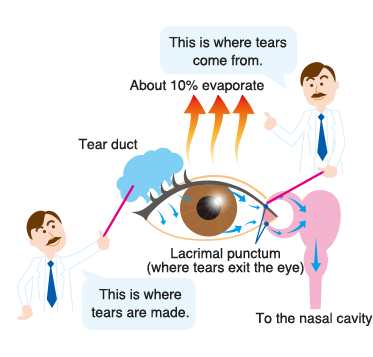
The role of tears
Tears are secreted from the tear ducts in the corner of the eye.
The main role of tears is to protect the eyeball but they also have a lot of other duties.
As a lubricant for your eyelids.
As a nutritional supplement for the surface of the eyeballs.
To protect your eyes from bacteria or ultraviolet rays.
To disinfect bacteria.
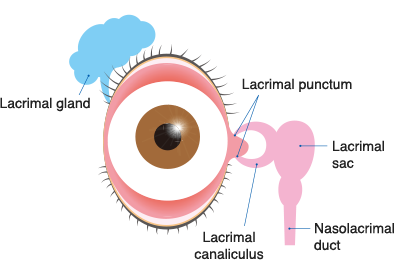
Anatomical drawing of the Lacrimal duct
(where tears pass)
Tears normally enter the Lacrimal canaliculus through the Lacrimal punctum, two small holes on the inner side of the eyelid of both eyes towards the inner corner. From here they flow down to the nasal cavity through the nasolacrimal duct.
The passage from this Lacrimal punctum to the nasolacrimal duct where the tears pass along is called the tear duct.
What sort of illness is epiphora?
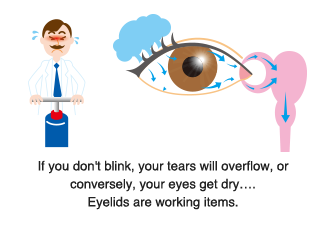
When tears accumulate the eyelids work like a pump when you blink to sweep them to small holes on the inside of the eyelids, through which they pass through the tear ducts to the nasal cavity (tear drainage).
When the tear duct is blocked or gets narrowed by certain reason, your tears will overflow like you are constantly crying (Lacrimal duct obstruction).
Epiphora can also occur due to an increase in tear production, but this brochure will discuss epiphora (Lacrimal duct obstruction) due to problems with tear drainage.
(Do you have these symptoms?)
- Your eyes are filled with tears, blurring your vision
- You often get lots of eye mucus
- The skin around your eyes is inflamed
When the tears don't drain properly, even the slightest stimulus can cause them to overflow, blurring your vision, and the constant flow of tears inflames the skin around your eyes. In addition, leaving this untreated can cause infection from bacteria and may lead to dacryosistitis because, bacteria in the tear duct doesn't get washed away nor untainted. This will increase the amount of eye mucus; make the corners of your eyes red and swollen, and sometimes painful.
The main cause of poor tear drainage is Lacrimal duct obstruction. It usually occurs with age, but can also occur through infection, medicine such as eye drops, fractures of facial bones, empyema, and other nasal diseases. Polyps or tumors can rarely cause epiphora as it forms inside the tear duct. In addition, causes other than Lacrimal duct obstruction can include dysfunction of the eyelid where the tear duct passes through or conjunctiva sagging by aging (conjunctivochalasis).
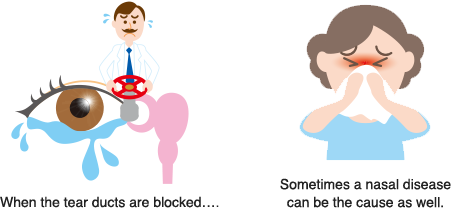
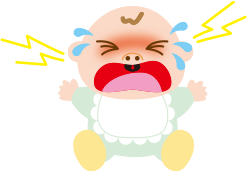
Congenital infant Lacrimal duct obstruction is comparatively common. Usually, if the tear ducts are closed at birth, they will open up and heal naturally as the infant grows. 90% of cases have healed naturally by one year old. Massage of the
Lacrimal sac is believed to help natural healing. If natural healing does not work, a lacrimal duct bougie (nasolacrimal duct release operation), which is a fine needle-like object, may be inserted into the tear duct to open up the obstructed
area, or a Lacrimal duct tube is inserted for a set period of time to treat the condition.
In addition, neonatal dacryocystitis can be caused by bacteria accumulating in the tear ducts, and so antibiotic eye drops are used in conjunction.
Epiphora Diagnosis (Examination)
With excess tears, the first thing to do is to check whether there is an increase in the amount of secreted tears (secretion volume) or whether there is a reduction in tear drainage. Some of the causes for increased tear production could
be foreign objects in the eye or ingrown eyelashes. Causes of reduced tear drainage such as eyelid dysfunction and conjunctiva sagging (conjunctivochalasis) are also checked.
Next, a Lacrimal canalilula irrigation test is performed. If no water flows through, a Lacrimal duct obstruction (LDO) is diagnosed, and the state of the tear duct is directly examined using an endoscope to determine exactly where the
blockage is. Depending on the situation, imaging tests such as CT scans may also be run.
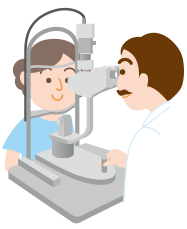
Slit-lamp examination
A vital part of an eye examination, which shines a light on the eye and around the eye for the observation of eyeball, through a magnifying glass. In this examination, the amount of accumulated tears is checked to see if it is greater than normal. In addition, the presence of foreign objects, ingrown eyelashes, and other causes of increased tear secretion are also checked. The movement of the eyelids and sagging in the conjunctiva are also checked.
Lacrimal duct irrigation test
The duct is irrigated with saline from the Lacrimal punctum to check if the fluid passes through to the nose.
Tear duct endoscopy
A fine endoscope, designed to be able to pass through the tiny Lacrimal punctum is inserted through the Lacrimal punctum and used to check where the tear duct obstruction is. Anesthetic may be injected into the tear duct before this test.
Nasal endoscopy
A special endoscope is inserted into the nasal cavity to observe the tear duct from the nasal cavity side. Anesthetic is given to the nasal mucous membranes before the examination.
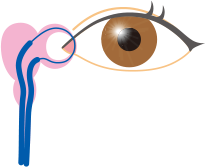
Lacrimal duct intubation
Using a tear duct endoscope, a special Lacrimal duct tube is inserted to reconstruct the tear duct. This is done under a local anesthetic, so the patient can return home on the same day. The inserted tube is almost invisible from the outside and it doesn't affect daily life. The tube is normally removed on an outpatient visit two to three months later. In this intubation method the tube is inserted into the tear duct, which cannot be seen from the outside, but recent uses of endoscopes during the surgery have made it able to be done accurately.
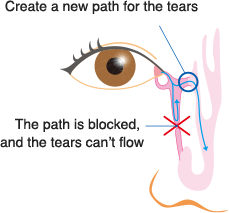
Dacryocystorhinostomy (DCR)
Depending on the location of the blockage, Lacrimal duct tube insertion may not always work well, or re-obstruction may repeatedly occur. When this happens, one method is to create a new tear duct using a surgery called dacryocystorhinostomy (DCR). There are two procedures for DCR: to cut part of the inner corner of the eye (external), or by using a nasal endoscope from inside the nose (endoscopic). This may be done under general anesthesia and often requires a hospital stay of several days to a week.
If you're having problems with epiphora, you don't have to live with it - see an ophthalmologist soon.
Do you have any of the following symptoms?
Doctor Inouefs Diagnosis
- Symptoms 1, 2, and 3 are believed to be caused by the dry eyes. In addition, Symptom 1 can also be caused by foreign objects in your eye or ingrown eyelashes, so both can be treated by removing the cause.
- Symptom 4 is a temporary issue caused by pollen or other allergens.
- Symptoms from 5 to 7 are considered to be the symptoms of a lacrimal duct obstruction, so treatment will be necessary.
- Symptom 8 means you are getting acute dacryocystitis, so you should see an ophthalmologist immediately.
(Source: "Surprisingly Many People Unaware that Teary Eyes Can be Cured," Body and Mind Report Card Asahi Shimbun, Feb. 21 2011)











